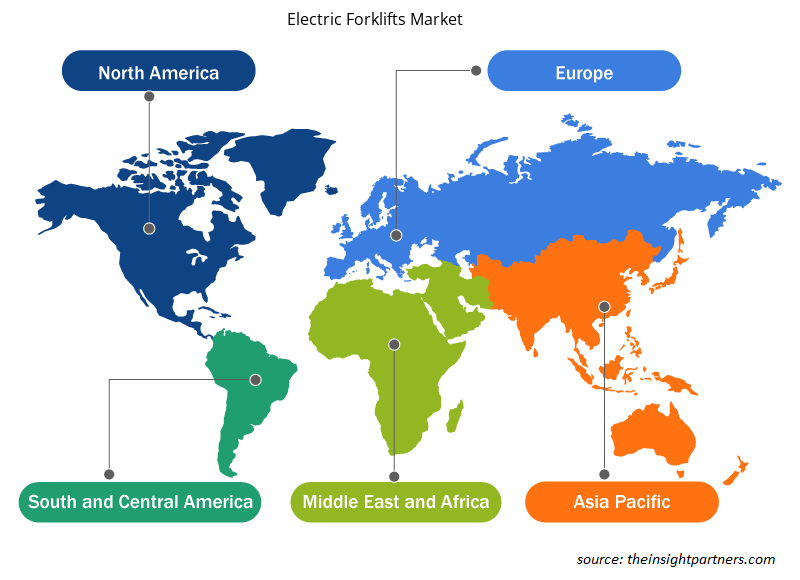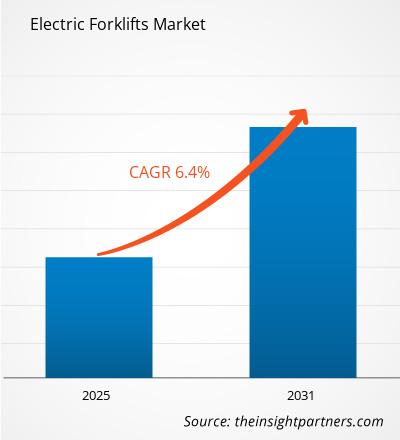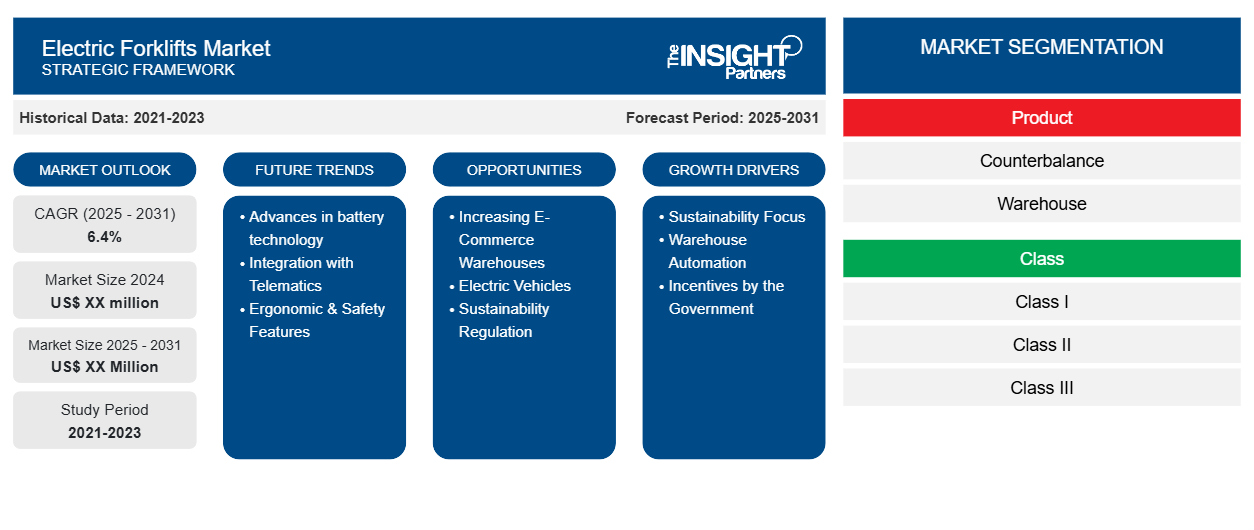Der Markt für Elektro-Gabelstapler soll von 2023 bis 2031 eine durchschnittliche jährliche Wachstumsrate (CAGR) von 6,4 % verzeichnen, wobei die Marktgröße von XX Millionen US-Dollar im Jahr 2023 auf XX Millionen US-Dollar im Jahr 2031 anwachsen soll.
Der Marktbericht für Elektrostapler ist nach Produkten in die folgenden Untersegmente unterteilt: Gegengewicht und Lager. Er ist auch nach Klassen unterteilt, darunter Klasse I, Klasse II und Klasse III. Darüber hinaus ist der Markt nach Endverbrauch kategorisiert, darunter Industrie, Lebensmittel und Getränke, Logistik, Einzelhandel und E-Commerce, Chemie und Sonstiges. Die globale Analyse ist auf regionaler Ebene und nach wichtigen Ländern aufgeschlüsselt. Die Marktbewertung wird für die obige Segmentanalyse in US-Dollar angegeben.
Zweck des Berichts
Der Bericht „Markt für Elektrostapler“ von The Insight Partners soll die aktuelle Situation und das zukünftige Wachstum sowie die wichtigsten Antriebsfaktoren, Herausforderungen und Chancen beschreiben. Dies wird verschiedenen Geschäftspartnern Einblicke geben, wie zum Beispiel:
- Technologieanbieter/-hersteller: Um die sich entwickelnde Marktdynamik zu verstehen und die potenziellen Wachstumschancen zu kennen, damit sie fundierte strategische Entscheidungen treffen können.
- Investoren: Durchführung einer umfassenden Trendanalyse hinsichtlich der Marktwachstumsrate, der finanziellen Marktprognosen und der Chancen entlang der Wertschöpfungskette.
- Regulierungsbehörden: Zur Regulierung von Richtlinien und Überwachungsaktivitäten auf dem Markt mit dem Ziel, Missbrauch zu minimieren, das Vertrauen der Anleger zu bewahren und die Integrität und Stabilität des Marktes aufrechtzuerhalten.
Marktsegmentierung für Elektrostapler
Produkt
- Gegengewicht
- Lager
Klasse
- Klasse I
- Klasse II
- Klasse III
Endverbrauch
- Industrie
- Essen und Trinken
- Logistik
- Einzelhandel und E-Commerce
- Chemisch
- Sonstiges
Geographie
- Nordamerika
- Europa
- Asien-Pazifik
- Süd- und Mittelamerika
- Naher Osten und Afrika
Geographie
- Nordamerika
- Europa
- Asien-Pazifik
- Süd- und Mittelamerika
- Naher Osten und Afrika
Passen Sie diesen Bericht Ihren Anforderungen an
Sie erhalten kostenlose Anpassungen an jedem Bericht, einschließlich Teilen dieses Berichts oder einer Analyse auf Länderebene, eines Excel-Datenpakets sowie tolle Angebote und Rabatte für Start-ups und Universitäten.
-
Holen Sie sich die wichtigsten Markttrends aus diesem Bericht.Dieses KOSTENLOSE Beispiel umfasst eine Datenanalyse von Markttrends bis hin zu Schätzungen und Prognosen.
Wachstumstreiber für den Markt für Elektrostapler
- Fokus auf Nachhaltigkeit: Der Fokus auf Nachhaltigkeit ist ein wichtiger Treiber des Marktes für Elektrostapler, da zunehmende Umweltprobleme zusammen mit extrem strengen Emissionsvorschriften den Übergang zu Elektrostaplern als sauberere Alternative zu Diesel erzwingen.
- Lagerautomatisierung: Das Wachstum im E-Commerce-Sektor und die steigenden Anforderungen an automatisierte Lager und Logistikzentren treiben die Nachfrage nach Elektrostaplern an, um die Erwartungen an hohe Effizienz und Zuverlässigkeit zu erfüllen.
- Anreize durch die Regierung: In den meisten Teilen der Welt bieten Regierungen Rabatte und Anreize an, sodass im Zuge verstärkter Nachhaltigkeitsbemühungen für Unternehmen die Umstellung von herkömmlichen Gabelstaplern auf Elektrostapler möglich wird.
Markttrends für Elektrostapler
- Fortschritte in der Batterietechnologie: Fortschritte in der Batterietechnologie aller Art – und insbesondere bei Lithium-Ionen-Batterien – tragen dazu bei, dass Elektrostapler die erforderliche Reichweite erreichen und sich mit der Zeit verbessern. Außerdem lässt sich der Gabelstapler dadurch schneller aufladen.
- Integration mit Telematik: Elektrische Gabelstapler sind jetzt mit auf dem Internet der Dinge basierenden Telematiksystemen integriert, um die Leistung in Echtzeit zu verfolgen, vorausschauende Wartung zu unterstützen und das Flottenmanagement zu verbessern.Telematics: Electric forklifts are now integrated with Internet-of-Things-based telematics systems to track performance in real time, support predictive maintenance, and improve fleet management.
- Ergonomische und Sicherheitsmerkmale: Bei der Entwicklung von Elektrostaplern achten Hersteller immer mehr auf ergonomische und Sicherheitsmerkmale. Zu diesen Merkmalen gehören beispielsweise eine verbesserte Sicht des Fahrers, Antikollisionssensoren und erhöhter Komfort.
Marktchancen für Elektrostapler
- Zunahme von E-Commerce-Lagern: Angesichts des starken Anstiegs des E-Commerce wird gesagt, dass der Betrieb von E-Commerce-Lagern einen erhöhten Bedarf an Elektrostaplern erfordert, da diese eine effiziente Materialhandhabung bei geringen Betriebskosten ermöglichen.
- Elektrofahrzeuge: Alle Branchen sowie in der Logistik tätige Unternehmen setzen auf 100 % elektrische Flotten. Daher wird die Nachfrage nach elektrischen Gabelstaplern weiterhin steigen.
- Nachhaltigkeitsvorschriften: Eine verschärfte staatliche Regulierung hinsichtlich Emissionen und Energieeffizienz dürfte den Herstellern elektrischer Gabelstapler auch größere Möglichkeiten bieten, die Nachfrage nach saubereren und effizienteren Materialtransportgeräten aufrechtzuerhalten.
Regionale Einblicke in den Markt für Elektrostapler
Die regionalen Trends und Faktoren, die den Markt für Elektrostapler im Prognosezeitraum beeinflussen, wurden von den Analysten von Insight Partners ausführlich erläutert. In diesem Abschnitt werden auch die Marktsegmente und die Geografie für Elektrostapler in Nordamerika, Europa, im asiatisch-pazifischen Raum, im Nahen Osten und Afrika sowie in Süd- und Mittelamerika erörtert.

- Holen Sie sich die regionalen Daten für den Markt für Elektrostapler
Umfang des Marktberichts über Elektro-Gabelstapler
| Berichtsattribut | Details |
|---|---|
| Marktgröße im Jahr 2023 | XX Millionen US-Dollar |
| Marktgröße bis 2031 | XX Millionen US-Dollar |
| Globale CAGR (2023 - 2031) | 6,4 % |
| Historische Daten | 2021-2022 |
| Prognosezeitraum | 2024–2031 |
| Abgedeckte Segmente |
Nach Produkt
|
| Abgedeckte Regionen und Länder |
Nordamerika
|
| Marktführer und wichtige Unternehmensprofile |
|
Dichte der Marktteilnehmer für Elektrostapler: Auswirkungen auf die Geschäftsdynamik verstehen
Der Markt für Elektrostapler wächst rasant, angetrieben durch die steigende Nachfrage der Endnutzer aufgrund von Faktoren wie sich entwickelnden Verbraucherpräferenzen, technologischen Fortschritten und einem größeren Bewusstsein für die Vorteile des Produkts. Mit steigender Nachfrage erweitern Unternehmen ihr Angebot, entwickeln Innovationen, um die Bedürfnisse der Verbraucher zu erfüllen, und nutzen neue Trends, was das Marktwachstum weiter ankurbelt.
Die Marktteilnehmerdichte bezieht sich auf die Verteilung der Firmen oder Unternehmen, die in einem bestimmten Markt oder einer bestimmten Branche tätig sind. Sie gibt an, wie viele Wettbewerber (Marktteilnehmer) in einem bestimmten Marktraum im Verhältnis zu seiner Größe oder seinem gesamten Marktwert präsent sind.
Die wichtigsten auf dem Markt für Elektrostapler tätigen Unternehmen sind:
- TOYOTA MATERIALHANDHABUNG
- KION GROUP AG
- JUNGHEINRICH AG
- MITSUBISHI LOGISNEXT CO., LTD.
- CROWN EQUIPMENT CORPORATION
Haftungsausschluss : Die oben aufgeführten Unternehmen sind nicht in einer bestimmten Reihenfolge aufgeführt.

- Überblick über die wichtigsten Akteure auf dem Markt für Elektro-Gabelstapler
Wichtige Verkaufsargumente
- Umfassende Abdeckung: Der Bericht deckt die Analyse der Produkte, Dienste, Typen und Endbenutzer des Marktes für elektrische Gabelstapler umfassend ab und bietet einen ganzheitlichen Überblick.
- Expertenanalyse: Der Bericht basiert auf dem umfassenden Verständnis von Branchenexperten und Analysten.
- Aktuelle Informationen: Der Bericht stellt durch die Abdeckung aktueller Informationen und Datentrends Geschäftsrelevanz sicher.
- Anpassungsoptionen: Dieser Bericht kann angepasst werden, um spezifische Kundenanforderungen zu erfüllen und die Geschäftsstrategien optimal anzupassen.
Der Forschungsbericht zum Markt für Elektrostapler kann daher dabei helfen, die Branchensituation und Wachstumsaussichten zu entschlüsseln und zu verstehen. Obwohl es einige berechtigte Bedenken geben kann, überwiegen die allgemeinen Vorteile dieses Berichts tendenziell die Nachteile.
- Historische Analyse (2 Jahre), Basisjahr, Prognose (7 Jahre) mit CAGR
- PEST- und SWOT-Analyse
- Marktgröße Wert/Volumen – Global, Regional, Land
- Branchen- und Wettbewerbslandschaft
- Excel-Datensatz
Aktuelle Berichte
Erfahrungsberichte
Grund zum Kauf
- Fundierte Entscheidungsfindung
- Marktdynamik verstehen
- Wettbewerbsanalyse
- Kundeneinblicke
- Marktprognosen
- Risikominimierung
- Strategische Planung
- Investitionsbegründung
- Identifizierung neuer Märkte
- Verbesserung von Marketingstrategien
- Steigerung der Betriebseffizienz
- Anpassung an regulatorische Trends























 Kostenlose Probe anfordern für - Markt für Elektro-Gabelstapler
Kostenlose Probe anfordern für - Markt für Elektro-Gabelstapler